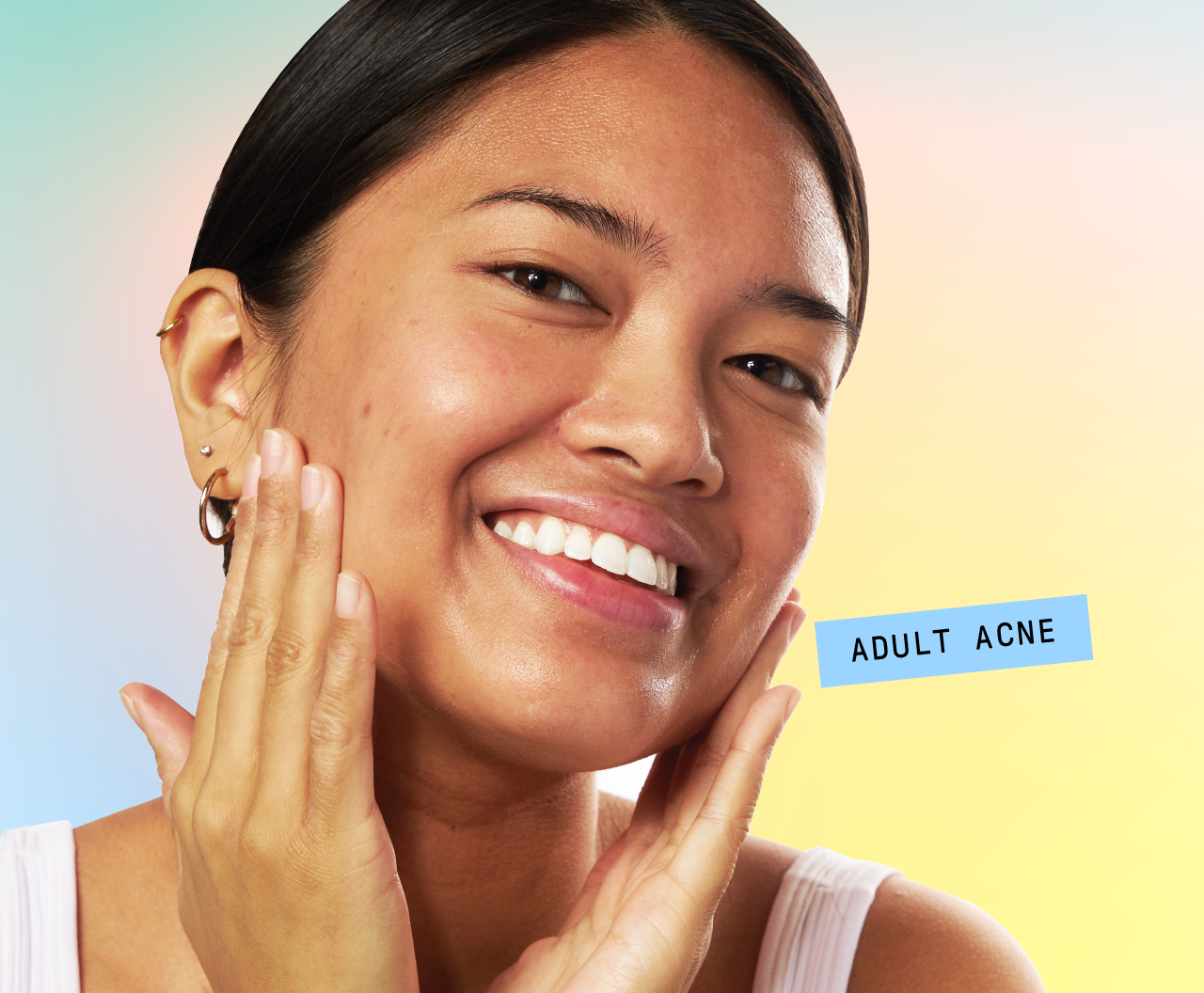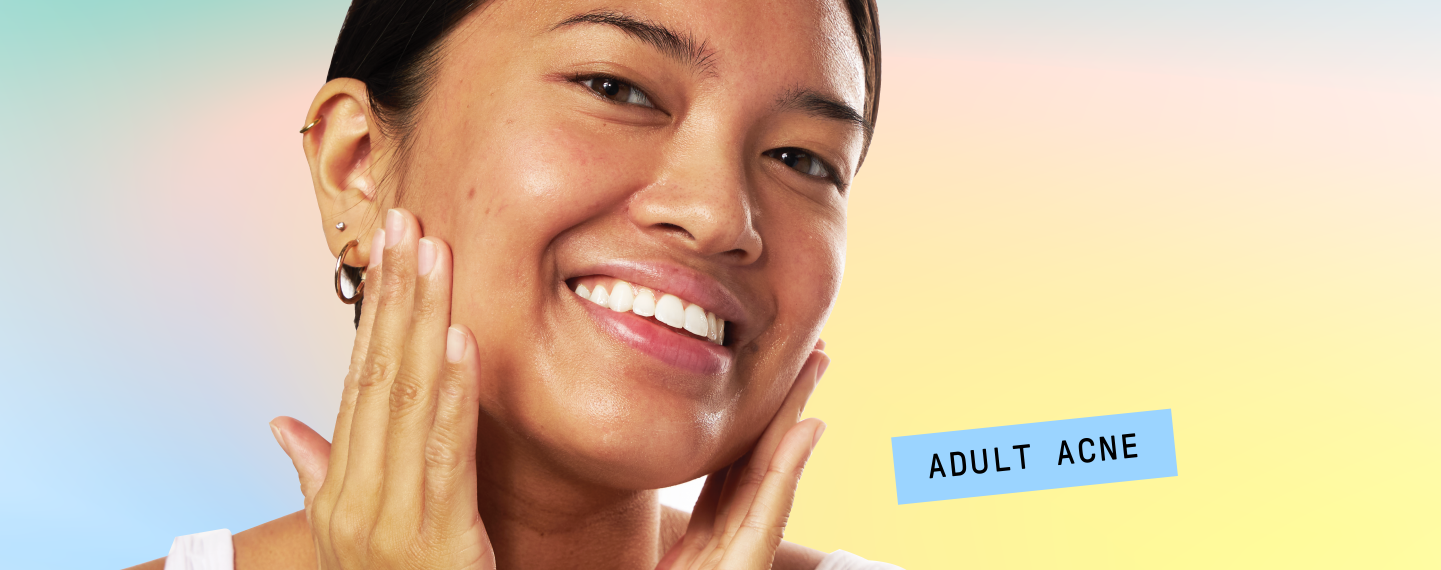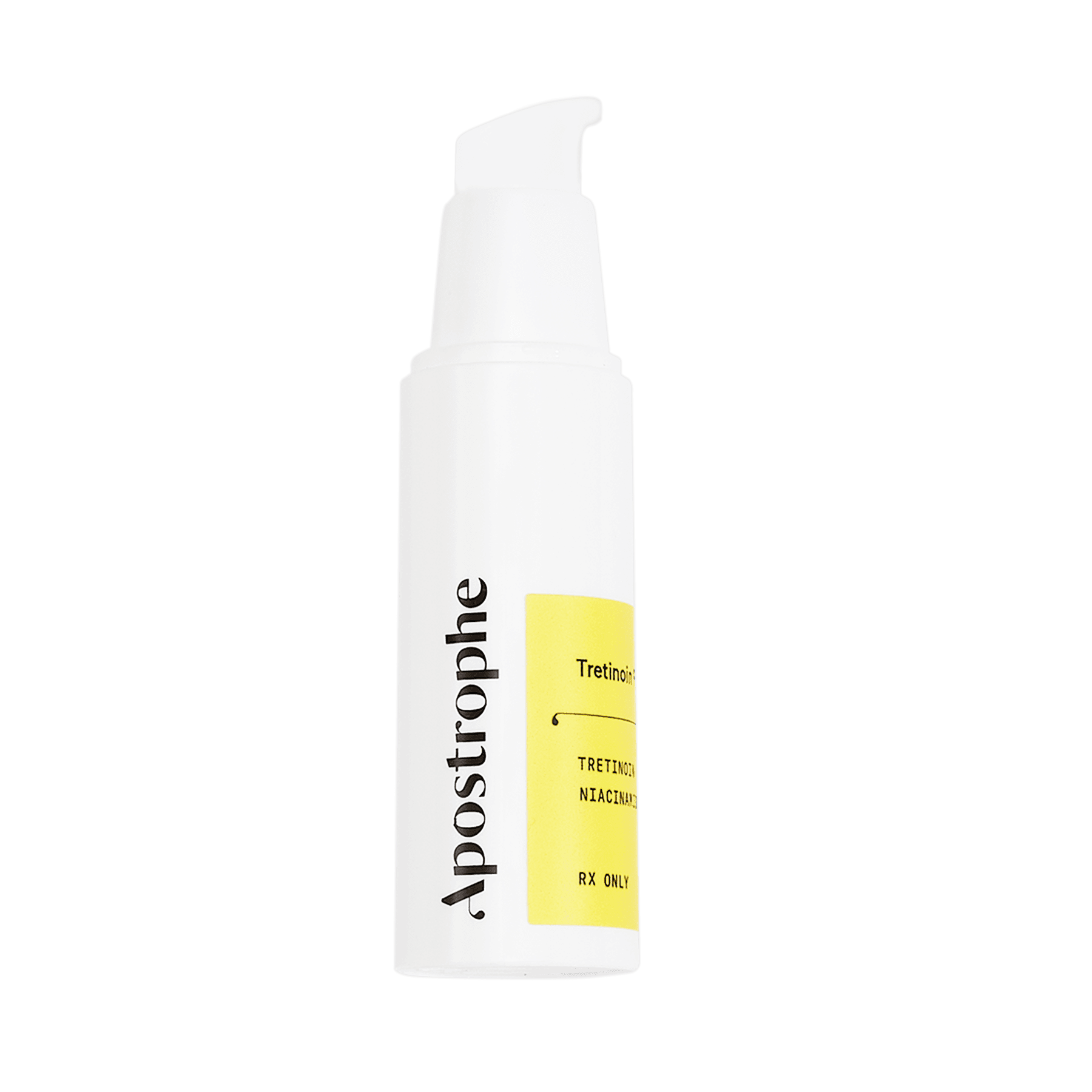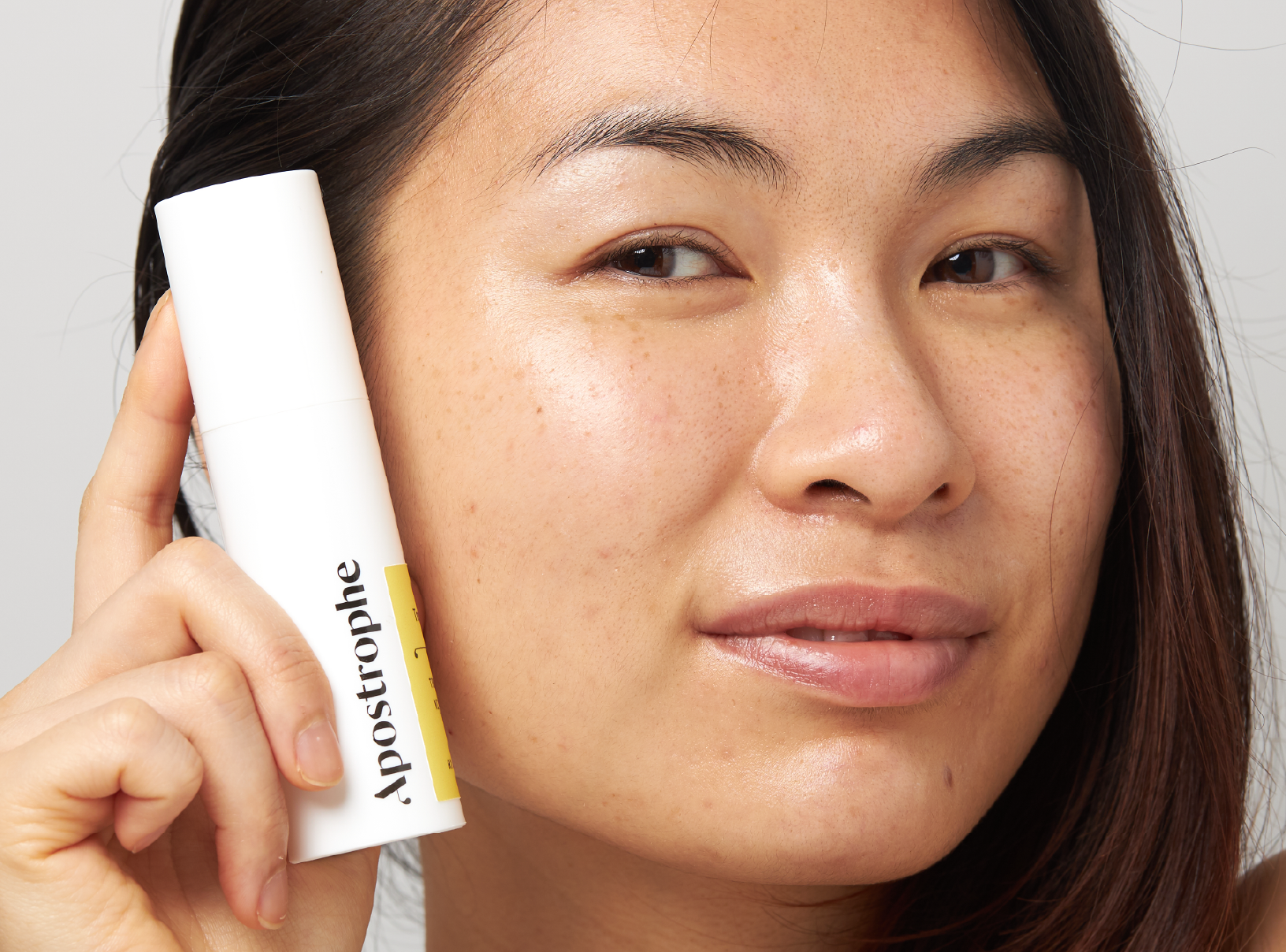Education
Best adult acne treatment


SHARE
Education
Best adult acne treatment
Medically reviewed by Katelyn Hagerty FNP
Written by Apostrophe Team
Last updated 11/3/2024
If anyone had told you at 14 that 20-, 30-, or even 50-year-olds could still deal with acne, you'd probably have closed the AIM chat immediately. But not without first sending a laughing face emoji.
Unfortunately, they'd have been correct. Fast forward a few years, and there's a chance you're among the nearly 15 percent of women who have to deal with adult acne.
Adult acne may continue from where your teenage breakouts left off. It can also spontaneously appear in your adult years, despite being a no-show during adolescence. In some cases, this sneaky, recurring condition may appear in your teens, leave for a little bit, only to re-appear in your adult years.
The good news is, this condition can be managed with the right practices and skincare products.
Even better news, we'll be sharing the ingredients to look out for when selecting these products. We'll also let you in on some of the reasons you may deal with adult acne.
Causes of Adult Acne
Acne starts to count as “adult” after the age of 25 — however, just about the same factors responsible for teenage acne come into play with this condition. These factors include:
Hormones
Hormones help the cells in your body communicate. Now, we're not ones to pick favorites — but on one hand, there are hormones like estrogen that help with developing sexual characteristics and regulating the function of sebaceous glands.
On the other, androgens like testosterone not only stimulate the growth of sebaceous glands, but encourage the production of sebum (oil), a big factor responsible for the appearance of acne.
Likewise, hormonal fluctuations right before your period hits can also lead to adult acne.
Genes
We hate to break it to you, but if you've had your fair share of adult acne, there’s a chance this condition was graciously handed down to you from within your gene pool.
A genetic predisposition to acne increases your chances of having breakouts in later years.
This predisposition influences the number, size, and activity of sebaceous glands responsible for producing oil in the body. Your genes may also influence hormones and your body's immunity.
Diet
A big pro of becoming an adult is finally getting the chance to have ice cream for breakfast, bagels for lunch, and whatever floats your taste buds for dinner. Unfortunately, certain foods — much like these options, can also increase your chances of developing adult-sized acne.
These foods raise your blood sugar quickly, which in turn releases a hormone called insulin. When excessive amounts of this hormone show up in your blood, oil glands produce more oil, increasing the risk of acne.
Medication
In some cases, drugs like benzodiazepines which are used to manage anxiety, stress etc, may lead to acne. Likewise, lithium, which is used to treat bipolar disorder and certain antidepressants can be the leading causes of acne.
Stress
There aren't many things stress is good for, and glowing skin definitely isn't on the list. When your body is under stress, you tend to produce increased levels of the hormone cortisol.
This bad boy binds to the sebaceous glands, increasing your body's oil production, and your chances of showing up at work with a fresh set of stress breakouts.
Other factors like the tobacco enjoyed during smoke breaks, or diseases like Polycystic ovary syndrome (POS) can also contribute to adult acne.
The Best Skincare Ingredients to Manage Adult Acne
Acne, especially in its mature, adult form, has rightfully earned its place as a pretty annoying skin condition to deal with. This may explain why there's a whole industry dedicated to its management.
While there's no shortage of products to minimize the appearance of acne, to really get your treatment right, extra care has to be paid to the ingredients that go into these products. A few tried and trusted options include:
Tretinoin
This retinoid is a big deal in the acne-busting universe. First off, it's comedolytic, which is fancy-speak for saying it won't clog your pores.
But beyond that, tretinoin also puts in the work to unclog your pores, while also encouraging the normal movement of oil in your skin.
This ingredient also encourages the production of new skin cells and has anti-inflammatory benefits — a crucial feature for fighting off acne.

PRESCRIPTION TRETINOIN
Target acne, dark spots, and signs of aging with this science-backed ingredient.
Azelaic acid
This acid hits the trifecta when it comes to fighting acne: it is antibacterial, helping to fend off p.acnes, the acne-causing microorganism. Azelaic acid also has anti-inflammatory properties, which is good news for preventing acne.
To top things off, this acid can also help to correct hyperpigmentation following an acne breakout.
And last but not least, we should note that azelaic acid also has comedolytic properties.
Niacinamide
There's a reason niacinamide is all the rage in lotions, serums, moisturizers, and other skincare products.
Make that two reasons. In managing acne, niacinamide has potent anti-inflammatory properties, and can also help to reduce the production of oil in the body. This ingredient has also led to notable improvements in acne.
Salicylic acid
You know how acne is formed when oil, dead skin cells, or bacteria stick together and form a pact underneath your skin? Salicylic acid comes in to break the party up. It achieves this by dissolving the glue that holds the pore-clogging materials together.
It also has mild anti-inflammatory abilities and can help to fight off acne-causing bacteria.
Benzoyl peroxide
This ingredient is non-clogging, has anti-inflammatory properties, and will also help to clear a build-up of comedones in your skin. It also has antibacterial properties which is why it earns top marks in managing acne.
You can apply benzoyl peroxide as a cream, gel, or lotion to the parts of your body affected by acne.
Sulfur
We know it doesn't have the best smell... alright, it stinks — but don't give up on sulfur just yet.
This ingredient can help to fight off acne-causing bacteria and may be useful in breaking down keratin, a protein needed for hair growth which can cause acne in excess.
Other ways to manage adult acne
While you get your acne under control with the right ingredients, your skin can benefit from observing the following practices:
Gentle skin handling — that means no attempting to scrub the acne away, which can leave your skin irritated.
Use oil-free skincare products and make up to avoid clogging your pores.
Use sunscreen, but also look out for oil-free options.
Closing off
It was hard enough dealing with acne while wearing backpacks and glitter lip gloss. Pairing acne with the responsibilities of your 20s, 30s, 40s, and 50s is just one more thing you'd be happy to do without.
Thankfully, ingredients like azelaic acid, sulfur, niacinamide, and others can help with the management of this condition.
You can learn more about acne and other skincare tips by taking a quick look at this handy guide.
Shop this post

Tretinoin
Like what you just read? Sign up for our email list to get the scoop on skincare science delivered straight to your inbox.

Deep Dives
A dermatologist shares his thoughts on the recent studies about benzoyl peroxide and benzene.
Read More
Education
What is milia?
What is milia? Today, we’re jumping into one type of bump that you may have heard about most commonly in infants — milia.
Read More
Education
Best moisturizer for acne-prone skin
If you have combination acne-prone skin, figuring out which moisturizer is best for your skin might be tough. In this guide, we break down the best moisturizer for combination, acne-prone skin.
Read More